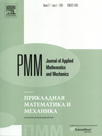 | | Journal of Applied
Mathematics and Mechanics
Russian Academy of Sciences | | Founded
in January 1936
(Translated from 1958)
Issued 6 times a year
ISSN 0021-8928
(print version) |
Archive of Issues
| Total articles in the database: | | 10610 |
| In Russian (¤╠╠): | | 9811
|
| In English (J. Appl. Math. Mech.): | | 799 |
|
| << Previous article | Volume 73, Issue 2 / 2009 | Next article >> |
| L.D. Akulenko and A.S. Kovaleva, "Estimation of the time a perturbed Lagrangian system stays in an assigned region," J. Appl. Math. Mech. 73 (2), 115-123 (2009) |
| Year |
2009 |
Volume |
73 |
Issue |
2 |
Pages |
115-123 |
| Title |
Estimation of the time a perturbed Lagrangian system stays in an assigned region |
| Author(s) |
L.D. Akulenko (Moscow, Russia, kumak@ipmnet.ru)
A.S. Kovaleva (Moscow, Russia) |
| Abstract |
The problem of estimating the mean time a weakly perturbed dynamical system stays in a fixed region of the phase variables is investigated. The motion is described by Lagrange's equations with an attractive force potential and in the presence of additive dissipative forces. The corresponding Cauchy problem is obtained in Hamiltonian variables for a non-linear first-order partial differential equation. Its classical positive solution specifies the action functional and the estimate sought for the time interval. The structure of the equations that allows of an explicit solution in terms of expressions for the kinetic and potential energy, as well as dissipative and dispersion matrices for a random Wiener-type perturbation, is established. The phenomenon of the escape of a phase point from different parts of the boundary of the region is investigated. Interesting problems of estimating the time for the inversion of the inner gimbal of a gyroscope, the time taken to reach an assigned level or a potential barrier of a multidimensional oscillatory system that has central symmetry, and the time a non-linear system with two degrees of freedom takes to escape over a potential barrier for a HenonľHeiles potential are investigated as examples. |
| Received |
12 August 2008 |
| Link to Fulltext |
|
| << Previous article | Volume 73, Issue 2 / 2009 | Next article >> |
|
 If you find a misprint on a webpage, please help us correct it promptly - just highlight and press Ctrl+Enter If you find a misprint on a webpage, please help us correct it promptly - just highlight and press Ctrl+Enter
|
|

 Russian
Russian  English
English